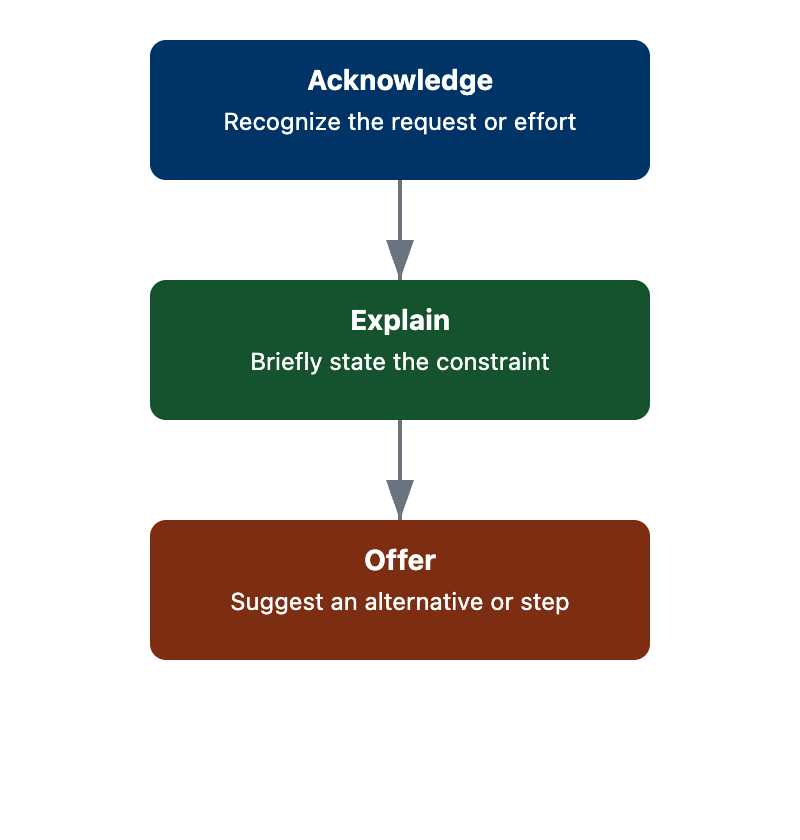Managing your executive’s schedule is a lot like tending a well-planned garden. Each meeting or commitment is a plant that needs the right amount of space, time, and attention to flourish. You don’t just add new plants wherever there’s room. You carefully consider how each one fits, making sure nothing is overcrowded and everything has what it needs to grow. Sometimes, when a new plant (or meeting request) comes along, you have to say “not right now” or suggest a better spot to keep the whole garden balanced and healthy.
To keep your executive’s schedule thriving:
- Spot conflicts early so you can resolve them efficiently and avoid unnecessary stress.
- Decline requests with empathy and care, always protecting your executive’s time.
- Set clear boundaries to maintain strong relationships and ensure everyone feels respected.
For example, when you notice a double booking or overlapping commitment, address it promptly and focus on finding a solution rather than assigning blame. You might say:
"I’ve noticed you have both the client review and the leadership sync at 2 PM on Thursday. Would you prefer to reschedule the leadership sync, or should I see if the client review can be moved to later in the day?"
This kind of direct, constructive communication shows you’re proactive and attentive — just like a good gardener who keeps everything in harmony.
You’ll often need to turn down meeting requests due to limited availability.
The key: be clear, kind, and concise — no need to over-explain. People appreciate straightforward communication that respects their time and avoids unnecessary details. By getting to the point while maintaining a warm tone, you help others quickly understand the situation and feel valued, even when you have to say no or suggest an alternative.
Here is how these skills sound in action:
- Ryan: Hi Jake, I was hoping to schedule a quick call with Jamie this Wednesday afternoon to discuss the new project proposal. Is Jamie available?
- Jake: Thanks for reaching out, Ryan. Jamie is fully booked on Wednesday. If you’d like, I can pass along a summary of your proposal for Jamie to review, or we can look at scheduling a call later in the week.
- Ryan: Thanks, Jake. Sharing the summary sounds good for now. Let me know if Jamie has any questions.
- Jake: Will do, Ryan. I’ll make sure Jamie reviews it and gets back to you if anything comes up.
In this dialogue, Jake clearly and kindly communicates Jamie’s unavailability, offers helpful alternatives, and keeps the conversation positive—ensuring Ryan feels heard and supported while protecting Jamie’s time.
Balancing your executive’s time with the need to maintain strong connections is essential. When you need to say no, be respectful and offer alternatives.
You can use the Acknowledge, Explain, Offer framework to handle scheduling constraints with clarity and empathy. Let us explain this framework by looking at the previous dialogue between Ryan and Jake. Ryan asked if he could schedule a quick call with Jamie this Wednesday afternoon. Here is how Jake used the framework to offer an alternative solution:
-
Acknowledge: Recognize the request or the person’s effort.
Example: “Thanks for reaching out, Ryan.” -
Explain: Briefly and honestly state the reason for the constraint or unavailability.
Example: “Jamie is fully booked on Wednesday.” -
Offer: Suggest an alternative or next step to keep the relationship positive and the conversation moving forward.
Example: “If you’d like, I can pass along a summary of your proposal for Jamie to review, or we can look at scheduling a call later in the week.”

Using this framework ensures your communication is clear, kind, and solution-oriented. This helps you protect your executive’s time while maintaining strong professional relationships.
By mastering these techniques, you’ll confidently manage scheduling constraints and represent your executive with professionalism and care. Up next, you’ll put these skills into practice in the upcoming tasks to help you build confidence in real-world scenarios.
